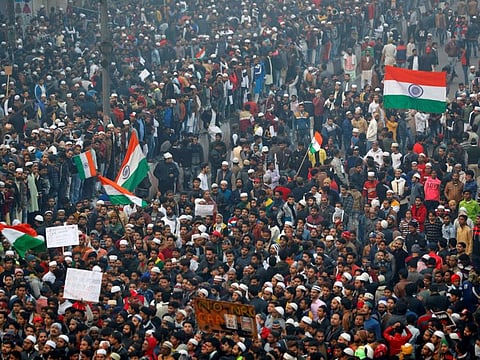Is India facing its worst crisis since independence?
While the economy is tanking, Modi continues to dominate the political landscape

Indian Prime Minister Modi in his second act says his first 100 days is but a trailer and tells his audience to patiently wait for the entire film. Meanwhile the film critics (who are generally wrong) goad the man saying, ‘It’s the economy, stupid’.
But have these movie buffs got it wrong, as is their wont?
For despite the clear and present danger that the Indian economy is creeping towards a free-fall, Modi continues to dominate the political landscape. Yes, much of his invincibility and aura has fallen by the way side but notwithstanding epithets like ‘Divider-in Chief’ he is still the strongest leader, India has seen for decades.
Unlike the American electorate where Trump’s base is numerically not that impressive, in India, Modi’s base is a large chunk of the Hindu population and this base thinks the economy can wait, let’s get the temple built, rewrite the constitution if needed because India’s true destiny is that of a Hindu State. Given this mind-set Modi is on track to keep his flockRavi Menon
The well respected ‘Foreign Policy’ magazine says ‘Everyone Thinks the Economy Is Issue No. 1 for India’s Modi. It’s not’. Meanwhile the ‘Economist’ in its latest special report on India has published a series of pieces titled ‘ The muddle Modi made’, ‘The two Modis’, and ‘ All hat, no cattle’ that are scathing.
To get a more well-rounded view the reader would do well to read Tribune’s ‘Economic heft matters’ written by Shyam Saran, arguably the most accomplished Indian diplomat over the past four decades.
Saran in his usual insightful and candid furrowing of truths says if India and its visionary leaders want India to be recognised as a truly civilisational power then ‘it’s, economy stupid’ has to be India’s mantra. Saran, of course, dwells on the strategic necessity of such an approach and less on the tactical compulsions of winning elections.
Delivering the agenda
Meanwhile let’s spend time on Foreign Policy’s line ‘little separates various Indian political parties on the economy. That’s why the prime minister’s new government is making its mark by delivering on its social and cultural agenda’.
It then goes onto say ‘there were several reasons for Modi’s popularity…the BJP’s well-oiled and well-funded election machinery…. the weakness of the opposition…but the broader takeaway is that economic indicators such as growth rates and stock market numbers have a limited impact on electoral prospects’.
So there you have it as to why the Modi-Shah combine are on a war footing to fulfil the many promises to its base: The Hindu middle class: Ergo, the Ram temple, the abrogation of Article 370, the Citizenship Act, and so on so forth.
Economist also lays out the stark truth ‘Narendra Modi is damaging India’s economy as well as its democracy: Growth fell from 8 per cent in the middle of last year to 5 per cent year-on-year in the most recent quarter. That might not sound too bad, and other emerging economies are also suffering, but India needs to grow fast just to keep its vast workforce fully employed.
Worse, the slowdown looks less like a dip than a prolonged cold shower. Some banks and many other lenders are in crisis, with a $200 billion mountain of bad debts. In the six months ending in September, the total flow of financing to businesses fell by 88 per cent. Five successive rate cuts by the Reserve Bank of India, the central bank, have failed to pull down commercial lending rates, and in any case firms are not investing. Consumer demand has levelled off or fallen, too.
Below expectations
Sales of cars and motorbikes have tumbled by 20 per cent or more. And with the combined fiscal deficit of the federal government and the states already approaching 9 per cent of GDP, and tax receipts falling well below expectations, there is little scope for stimulus.
Despite such dire warnings Modi marches on with his divisive agenda, but New Yorker asks ‘Has Modi finally gone too far’? It would appear Modi has taken a leaf out of President Trump tactic ‘protect your base, the rest does not matter’.
And unlike the American electorate where Trump’s base is numerically not that impressive, in India, Modi’s base is a large chunk of the Hindu population (Hindus constitute close to 80 per cent of 1.3 billion of India’s population) and this base thinks the economy can wait, let’s get the temple built, rewrite the constitution if needed because India’s true destiny is that of a Hindu State. Given this mind-set Modi is on track to keep his flock.
Here it is worthwhile listening to eminent jurist Fali Nariman, the country’s leading light on all matters judicial and the constitutional. He says when the country adopted a liberal secular constitution in 1950s there were serious objectors even then (motor mouths like Pragya Thakur) but despite that the Hindu middle class voted against a Hindu State.
However in Modi’s India if the same Hindu middle class has turned its back on a secular constitution, the minorities then have no choice but accept it.
Grim tidings indeed! The country is in for long vigil: The dark night of the soul is upon it.
— Ravi Menon is a Dubai-based writer, working on a series of essays on India and on a public service initiative called India Talks
Sign up for the Daily Briefing
Get the latest news and updates straight to your inbox



